You know water is vital to emergency preparedness — you can only survive three days without it — and you probably know it can be hard to get consistent and clean water in a SHTF disaster. You can’t depend on “running to the store” at the last minute or carrying all the water you need. Unsafe drinking water causes half of all the occupied hospital beds in the world and over two million preventable deaths each year. Prepare now and avoid the pain later.
We spent 48 hours researching and reviewing over 70 portable survival water filters for preppers so that you don’t have to — and more importantly, so that you don’t buy a bad product and die.
This review covers the kind of products you’d keep in your go-bags, perhaps with some extras in your home supplies or for everyday carry. These products should be one of your very first purchases in prepping.
Reviews: Portable water purification tablets, water canteens and home water filters
Full list of product reviews and details on prepping tips, water risks, etc. are below the table of contents.
Summary:
- Water, especially water affected by emergencies like grid failure or flooding, contains organisms that can make you very sick at the worst possible time.
- Water can be treated in a variety of ways: filter screens, purification chemicals (chlorination), boiling it away and recapturing the steam (distillation), reverse osmosis, UV light, or boiling. Each has its pros and cons.
- We recommend using filters for basic prepping needs because it’s the best way to quickly turn wild water into drinkable water.
- You should have at least two of the filters recommended in this guide in each one of your emergency bags. A mix of different types is the best, because no single product is perfect.
- We recommend keeping 16-24 oz (a normal water bottle) of potable water stored in your bags at all times, that way you have something to drink in the immediate aftermath.
- Your personal filter choice might come down to whether or not you care about virus protection. Viruses aren’t normally a problem in places like the US and Canada, but could be worse in an emergency or very hot climates. We think about virus protection as a nice-to-have if you can afford it.
- Companies are in an arms race to have the longest filter life. Giant numbers like 50,000 gallons are under perfect scenarios with clean input water.
- Capacity matters more when we’re judging numbers like 200 vs. 1,200 gallons. But once the numbers get really high, they start to matter less.
- There’s no singular perfect mix of products. But do think about how your multiple layers of water treatment products can work together: can you mix and match pieces, do you have vessels for storing clean or dirty water that can attach to your filters, etc.
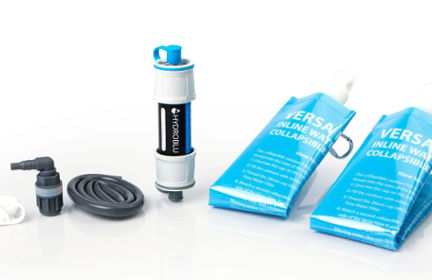
Best single product for most people:
HydroBlu Versa Inline Filter Kit
We like both the filter itself and this kit because it’s the best bang-for-your-buck. You can use the Versa in almost any possible configuration, such as drinking directly from a water source (like a straw), screwing it onto a standard bottle, or running it inline with a gravity bag or hydration bladder. The Versa is also easy to clean in the field. We appreciate the 28 mm threads on both ends, something almost no other filter offers, so you can attach it directly to most standard water/soda bottles. The kit, which is only $3 more than the filter itself, includes two 64 oz collapsible bags, tubing, and a bucket adapter for gravity setups — making this a cheap DIY gravity kit, too. If your budget is tight, you can buy the filter on its own, then add some 28 mm canteen bags and hoses later.
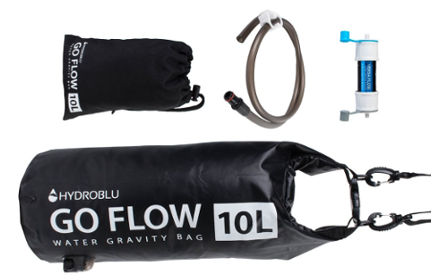
Best gravity kit:
HydroBlu Go Flow Gravity Kit
Honorable mentions
Absolute best: MSR Guardian pump
Everyday carry: HydroBlu Sidekick pen
Cheapest virus protection: Survivor Filter Straw
Cheapest virus pump: Survivor Filter PRO
Best bottle: LifeStraw Go
Virus bottle: Lifesaver Liberty
One kit that does everything: Renovo MUV
Preppers should use a mix of water filters
You shouldn’t buy one thing and be done. Even a minimalist go-bag should have a filter and a purifier, so you have two ways of creating drinkable water. Not just because of backups and the “two is one, one is none” philosophy — a mix of types means you’ll have all of your bases covered and can adapt to the emergency.
Three example mixes (limited to filters) of what you might find in someone’s emergency bag:
Basic: HydroBlu Versa kit + LifeStraw Go bottle = $60
Mid range: HydroBlu Versa Go Flow gravity kit + LifeStraw Go bottle + Survivor Straw kit = $130
Upgrade: MSR Guardian pump + HydroBlu Go Flow gravity kit + LifeSaver Legacy bottle = $480
Be prepared. Don’t be a victim.
Want more great content and giveaways? Sign up for The Prepared’s free newsletter and get the best prepping content straight to your inbox. 1-2 emails a month, 0% spam.
- Why you should trust us
- Important context for preppers
- Common risks in untreated water
- Water sources in an emergency
- Which methods are best for prepping?
- How portable water filters work
- Types of survival water filters
- Top brands
- How we review
- Best straws
- Best bottles
- Best pumps
- Best inlines
- Best gravity kits
Why you should trust us
We’ve spent over 48 hours researching and reviewing over 70 products, narrowing it down to the top 5-10 in each category before deeper testing. I’ve been prepping for 14 years, teaching others for 11 years, and have used most of the name-brand filters on this list (and a few of the knockoffs).
How water purifiers fit into emergency preparedness
Following the beginner prepping checklist, there are three main scenarios you plan for:
- Staying home (bugging in or sheltering in place)
- Being able to leave your home at a moment’s notice (bug out bags)
- Being able to get home or get to safety if emergency strikes when you’re away (get home bags and everyday carry)
Even if you’re planning on staying home, one of the core sane prepper rules is that you can’t predict what will happen.
So you should be prepared to survive in case you have to leave or never make it home to begin with, making your home Brita filter worthless. You simply cannot depend on being able to buy water at the last minute, use your bathtub, or get free handouts from FEMA quickly enough to matter.
You should have small water containers for short term emergencies filled and stored in your home that cover at least the first two weeks.There are better water filter systems that make sense for a prepared home or large groups in fixed positions (like the Berkey filters). But those home filters aren’t practical for portable use and should only be taken on after covering these basics.
Redundancy is built into these models. Which also makes it easy for beginners or those on a budget to baby-step their way in. For example, your bug out bag is always packed and ready at home, so even if you do end up staying home during an emergency, you’ll have these portable filters on hand to compliment whatever larger water gear you have on hand.
Water is very heavy at 8.3 pounds per gallon. People need an average of one gallon per day — if not more when on foot. So the idea you’ll carry the water you need for days is a non-starter.
But we do recommend you keep 16-24 oz of potable water stored in your emergency bags at all times.
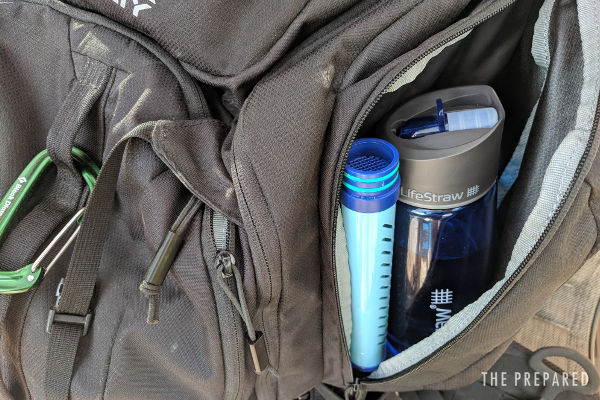
Water is so important, you don’t want to be worrying about finding a water source and filtering it in the minutes and hours after SHTF. This probably means having a rigid water bottle in your pack, which may or may not affect which filters you buy.
Screws on to most filters:
Evernew 2L Water Pouch
Think about cross contamination and how you’ll handle vessels that hold dirty water. Once a vessel holds bad water, you’ll ideally not put clean water in it until you’ve washed it out with soap. Some products below even give you separate “clean” and “dirty” bags.
Common risks in untreated water
Some people think “I’ve drank from streams before and never gotten sick, so I don’t need this.” There was even a (debunked) article that went viral arguing against the need for filters.
Don’t buy it. This is an important prep to have.
There are three main categories of water risks: sediments, biological organisms, and toxins. More specifically:
- Sediment: Solid stuff like dirt, sand, silt, debris, plant and animal matter.
- Algae: Green/blue/brown slime that grows in still water. The CDC reports harmful algae blooms are increasing due to climate change and industrial waste.
- Bacteria: Namely from human and animal fecal waste, like E. coli, salmonella, cholera, shigella, and coliform.
- Protozoa: Larger, more advanced single-cell organisms than bacteria that feed on organic matter, like giardia, cryptosporidium, and cyclospora.
- Cysts: These are just dormant forms of bacteria/protozoa waiting to ‘turn on’ once inside your body, but you sometimes see them listed separately in product marketing materials.
- Viruses: Hepatitis A, SARS, polio, and HFMD (hand, foot, and mouth disease) caused by viruses like norovirus and rotavirus.
- Chemicals, heavy metals, & society’s waste: Countless contaminants like oil, pesticides, cleaning agents, acid rain, industrial runoff, paint, or heavy metals like lead and mercury.
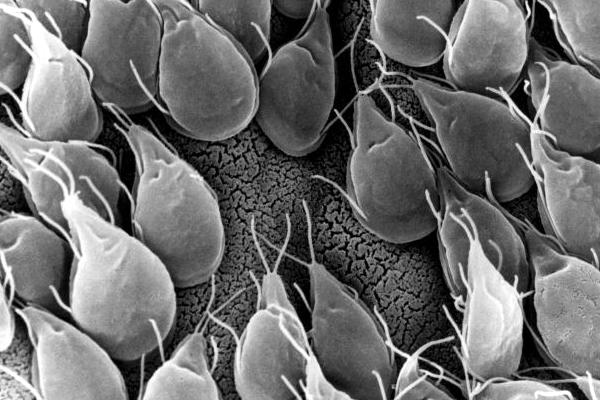
The two most common dangers in developed countries like the US and Canada are giardia and cryptosporidium, two unpleasant single-celled protozoan parasites that come from animal feces and can cause severe intestinal problems. They usually have more common non-scientific names like “beaver fever.” Cryptosporidium in particular has a hard outer shell, making it difficult to kill.

Viruses are generally not a threat in modernized countries with temperate climates, like the US or Canada. Water viruses are much more common in developing countries or areas with extreme climates, like Mexico or India.
Running water is generally safer than still water because nature acts like a filter/cleaner as water moves through it.
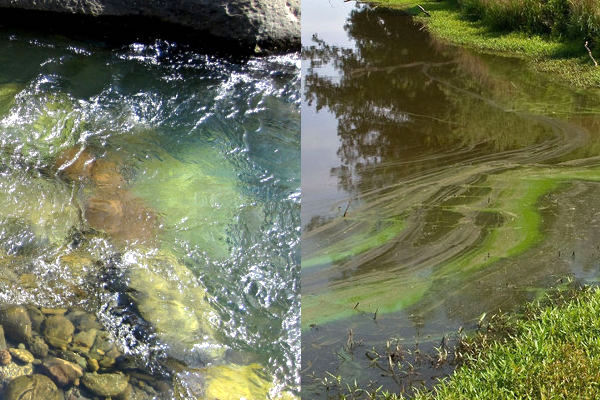
Non-living toxins are generally more of a threat the closer you are to dense cities and industrial or mining areas. We don’t ever assume water is 100% safe, but water in a remote mountain stream is likely safe from heavy metals and chemicals.
There are no portable survival filters that handle salt water and most won’t handle water-soluble chemicals (like fluoride) or industrial metals.
Water sources in emergencies
It’s important to be adaptable and not pigeonholed into overly-specific scenarios — easily one of the most common prepping mistakes we see everyday, including when buying water products.
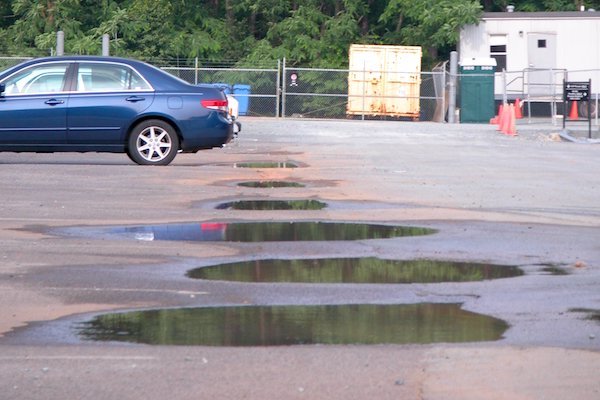
Don’t get tricked by product marketing: Most of you are more likely to be drinking from a dirty urban puddle than a clean mountain creek.
Unfortunately, the sources of water you’d naturally turn to in an emergency are becoming more contaminated every year because of human activity.
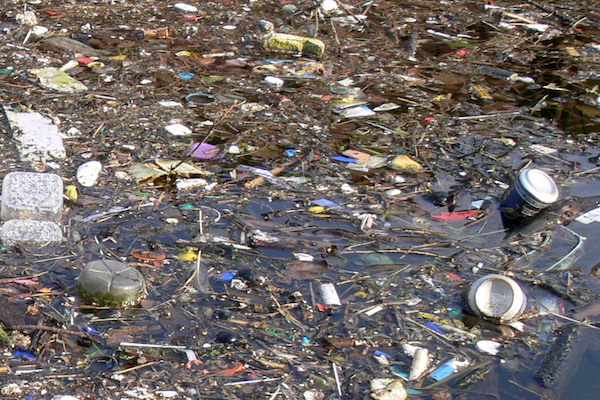
For example, even though 68 million pounds per year of the top 10 toxic industrial chemicals are improperly disposed of (polluting drinking water across America), after a successful lobbying effort by the chemical industry in 2018 the US EPA decided to stop considering the effect of toxins in water when evaluating risk.
During most emergencies, water sources and quality will be the same as normal.
But larger emergencies can quickly contaminate the water, such as hurricanes, flooding, grid/infrastructure failure, industrial accidents, biological contamination, and major SHTF scenarios.
If a storm floods your city, all of the surrounding water is likely tainted with industrial runoff, auto chemicals, and sewage.
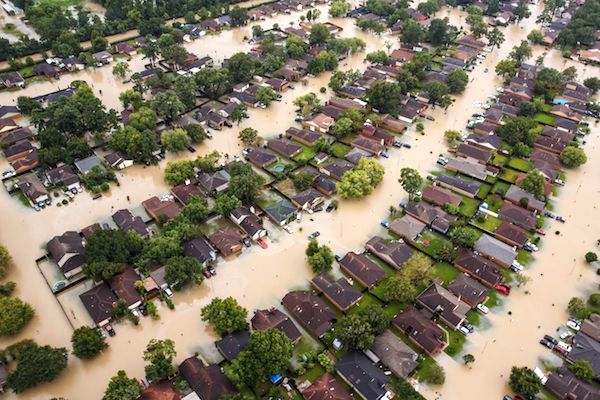
After Hurricane Harvey hit Houston in 2017, the water was so contaminated that people were getting sick just by walking through it. Medical tests showed the water had up to 5,700 times more bacteria than EPA standards.

Only 3% of sewage treatment plants in the Houston area were affected, but that was enough to massively contaminate the whole region — let alone all of the flooded dry cleaners, industrial plants, auto body shops, and so on that released “millions of pounds of pollutants”.
The risks are meaningful. A bout of gastroenteritis or Legionnaires disease will really make your bad days even worse. An emergency is not the time to be broken down from fatigue, diarrhea, and vomiting.
Best personal water treatment method for prepping
Each method has pros and cons — and no single method will make water 100% safe — but in the end we recommend filters for your basic prep supplies.
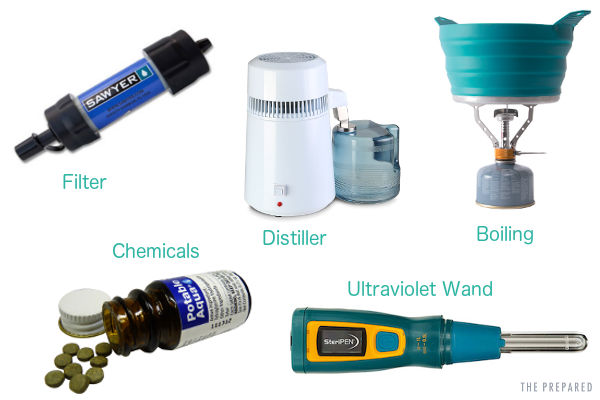
There are multiple ways to clean water in the field:
- Filter out the particulates large enough to be caught in a fine screen.
- Purify with chemicals like chlorine (aka chlorination), iodine, or ozone to kill or deactivate bad stuff in the water. Just like a swimming pool.
- Use UV light to kill living organisms (similar to how medical equipment is sterilized).
- Boil water to kill living things.
- Distill water by boiling it and catching the evaporating steam, recollecting it into liquid water. This leaves anything that wasn’t pure H2O behind.
When looking at the kinds of products relevant to personal emergencies, it usually comes down to filters versus purifiers. The best answer is to have both. But if you only have one, a filter is usually the better choice.
Review: Best portable water purifiers
Boiling takes time, fuel, and equipment. It’s a fine method, but it doesn’t make sense as a primary water plan in this context. Think of boiling as a backup or bonus.
While we do recommend having some purification chemicals on hand as a backup, we don’t recommend them as your primary plan.
For example, imagine you have filters in your bag that don’t protect against viruses. But the water around you seems sketchy or you know there’s an outbreak. You would filter the water to remove particulates, then boil it to kill anything left over.
Purifying chemicals seem attractive because they are relatively cheap, small, and lightweight. So they’re easy to buy and throw in a bug out bag pocket.
Besides wanting to avoid putting unnecessary chemicals in your body, chemical treatments take a long time — a normal-sized water bottle can take up to an hour or two to neutralize the hard-to-kill threats like cryptosporidium. Not only do they expire after a few years, but one water filter might clean up to 100,000 liters whereas a normal package of purification tablets might only clean 200 liters.
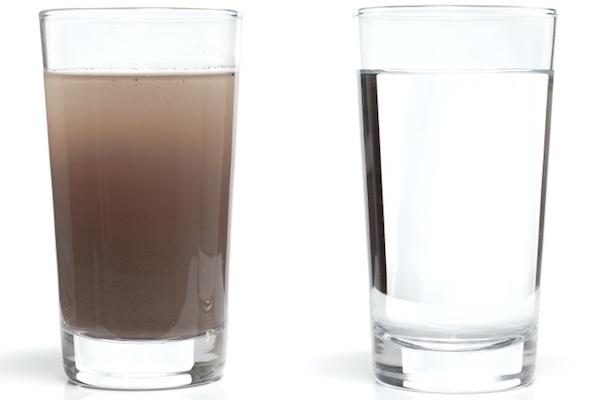
Chemicals, UV, and boiling will kill living contaminants but they don’t remove particulates and some chemicals. So you might end up drinking water that looks and tastes horrible even though it technically doesn’t have any living threats.
How portable water filters work
Filters use physical mesh screens to block particles. How effective the filter is depends on how small the pore holes are, which determines what it blocks versus what it lets through.
Common sizes:
- Human hair: 50 microns wide
- Algae: 5-20 microns
- Protozoa: 1-50 microns
- Coal dust: 1-50 microns
- Asbestos: 0.7-90 microns
- Bacteria: 0.2-1.0 micron
- Radioactive fallout: 0.1-10 microns
- Virus: 0.004-0.3 micron
- Lead: 0.001-0.7 micron
Note: Some products play marketing games by saying they have a “nominal” size of X microns. This means it can block down to that size, but not always — so look for “absolute” ratings instead. The CDC found that some “nominal 1 micron filters” still let through up to 30% of 1 micron threats.
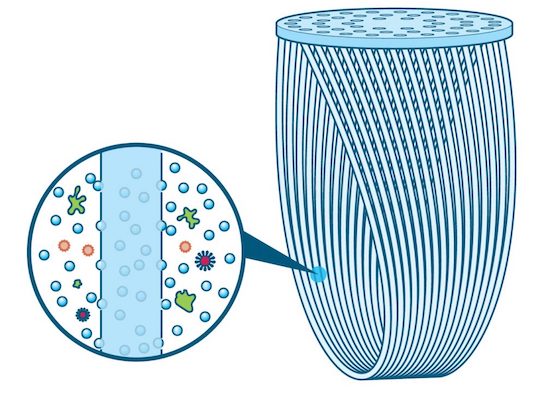
A virus can be 100 times smaller than bacteria, which is why any decent filter can screen out protozoa and bacteria, but only the tightest ones can filter viruses and other super-fine particles.
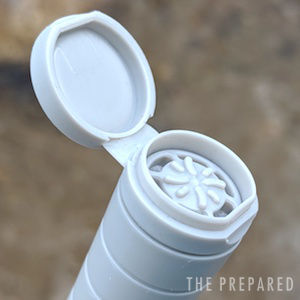
Some products mix technology, combining small filter pores with a kind of ionized coating around the mesh that attracts bad stuff as they float through. This is why some filters that are technically only 0.2 micron in size can still filter out 0.01 micron viruses.
Some filters also use activated carbon (e.g. activated charcoal) to attract and trap the smaller stuff that otherwise would slip through a mesh screen — similar to how activated carbon traps gases in prepper gas masks. Carbon will not only make the water taste and smell better, but it can remove some of the chemicals you’d rather not drink.
Fluoride, salt, and other elements are water soluble, which means they dissolve into the water and are no longer separate particulates that can be screened with a filter.
Types of survival water filters
The difference comes down to how the water is forced through a filter. Water is either sucked through via your mouth, pulled through via gravity, or pushed through via a pump or squeezing motion.
- Straw: The simplest filters that move water through via suction from your mouth as you drink.
- Bottle: Essentially straws that are mounted inside of a bottle, so they filter as you drink.
- Inline: Versatile filters that have simple input and output attachment points, so you can use it as a straw directly in the water, screwed onto a bottle top, with a hydration bladder, or with a gravity bag.
- Gravity: Uses gravity to pull water through filter, typically with a bag of dirty water elevated above an inline filter with hose connections.
- Pump: Your hand movement forces water through.
One of our frustrations with this market is that most products are designed for a specific hiking, camping, or international travel need — not emergency preparedness. Which creates unfortunate tradeoffs and products that are never quite perfect.
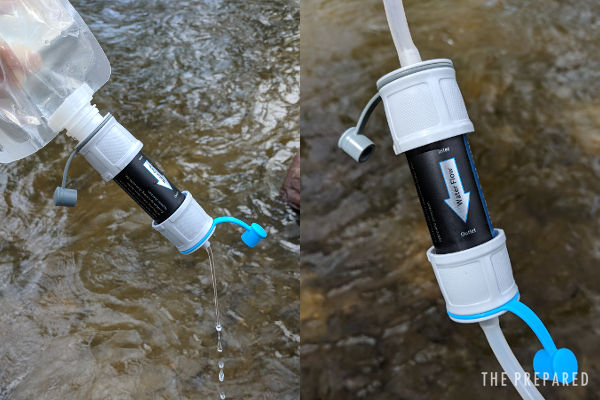
But newer filters (especially the inline models) are becoming more versatile, so you can use the filter in almost any possible configuration or scenario — something very important in prepping so that you can reduce weight and cost while increasing your ability to handle unpredictable scenarios.
Top brands
- Aquamira: Known for their chemical purification methods, they also created some of the first versatile inline filters.
- HydroBlu: A relatively new Utah-based player to the market that surprised us with some quality product offerings.
- Katadyn: Based in Switzerland, this venerable company is known for their tough ceramic pump filters that last a long time.
- LifeStraw: They blew up and owned the survival straw category, becoming the name brand most laypeople have heard of. But their products are limited and often not the best choice.
- MSR: Great tech with unique products, but they tend to stay within their own product ecosystem. For example, their pump filters directly attach to their branded water bladders, but don’t come with hoses to easily pump into other third party products.
- Platypus: A great company with solid products (like water bladder bags), but they don’t seem to make their water filtration stuff in house.
- Renovo: A new company, their whole thing is a modular, versatile product family. They have three filters (MUV 1/2/3) that connect together, so you can use any combo you want based on the water quality. Those filters can attach to a mouthpiece to make it a straw, inside a bottle, or to a pump housing.
- Sagan: A relatively new brand in the space from the same California-based folks as Kelly Kettle, and they seem to be doing it right.
- Sawyer: When we poll preppers, the Sawyer is by far the most-often-recommended brand. We don’t always think they’re the best, but it’s a tried-and-true company with a reputation for filters that last a very long time.
- Seychelle. Well known in the water purification industry, but their personal products relevant for prepping seem to have fallen behind the curve.
There are brands you often see popping up around sites like Amazon that are actually white-labelled brands that take other people’s products (typically from unknown Chinese manufacturers like Diercon) and slap their name on top. An easy way to tell is if you can’t find a good website for the company.
We try to avoid these products. Common examples:
- Aquaway
- Etekcity
- JBW
- Life Defender
- Nature’s Hangout
- Outdoors 365
- Survival Hax
How we review the best backpacking water filters
A good hiking or camping product might not be right for emergency preparedness. Context matters.
One example: The risk of contracting a virus from water in America is almost zero in normal life. So a recreational hiker measuring every ounce of carried weight doesn’t need to worry about having a filter that stops viruses. It would make sense for hikers to buy a cheaper filter that lasts longer and has a better flow rate (because of the larger filter pores).
Even if they did get sick, they’d have access to medical care. But both the risk and consequences are greater in some of the worst emergencies, so we consider viral protection more heavily.
We focus on product qualities that make sense for being away from home during a wide range of emergencies, such as:
- What kind of water and threats will it clean
- How portable is it
- Durability and shelf life
- Ease of use without instructions (the “10 year old child” test)
- Does it require batteries
- How much water can it clean without replacements or complicated maintenance
- How fast does it work
One of the trickiest parts is thinking about how you use various filters. Does it need a bag? Special hoses? Can you only use it in one situation? Will it work when you’re on foot in a suburb? In a desert?
For example, the most popular survival water filters (like the LifeStraw) have serious disadvantages because they only work when you are physically inches away from a water source. You have to bend down and put the straw into the water, sucking in with your mouth.
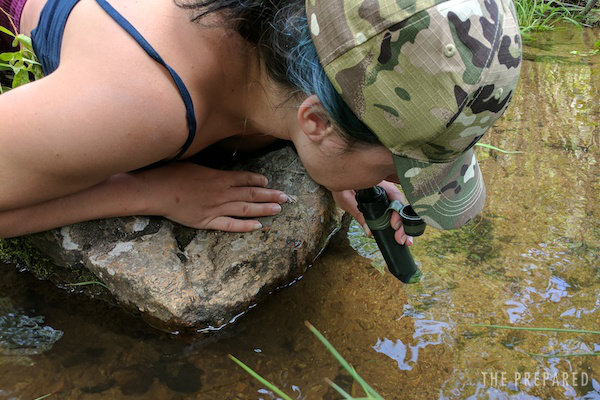
We greatly prefer products that give us the option to put clean water into whatever vessel we want, for as much quantity as we want.
We generally don’t like “modular” products, like the Renovo MUV, because they typically have more moving pieces, higher risks of failure, can be confusing in the field, and require you to go all-in on their systems.
Best survival straws
- Avoid straw models. It’s very common that someone new to prepping buys a LifeStraw or something similar as one of their first purchases because they saw a blogspam review promoting it. But there are very few scenarios where we’d rather have a straw instead of the other types.
- Exceptions: They can be great for everyday carry uses. Or if you really want to have a straw, think of it as a nice-to-have bonus.
- The difference between a straw model and an inline model is that straws do not have the easy ability to attach standard hoses to the input and output ends, requiring you to dunk the input end in the water and/or use your mouth to bring water through.
- One of the main disadvantages is that you can’t filter water and then store it in a vessel. It only filters in the moment as you suck water through and into your mouth. Imagine if you wanted to cook or store it for later: Are you going to spit the water back into a pot or bag?
- Another major disadvantage is you have to get your face a few inches away from the water source. Sounds good in theory, but is more difficult in practice.
- Can be hard to suck the water through, especially as the filters get clogged up over time and flow rate drops.
- Pros: cheapest, smallest, lightest, simplest.
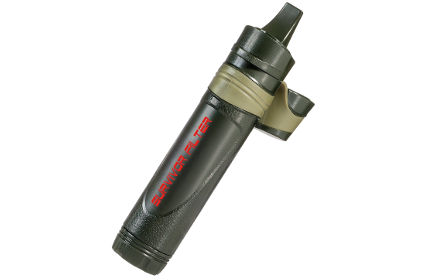
Best full-size straw:
Survivor Filter Straw
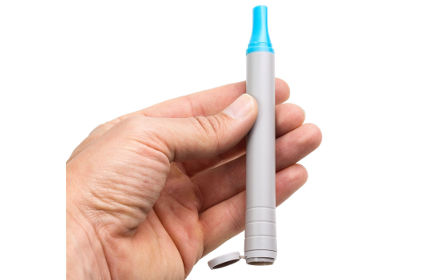
Best EDC straw:
HydroBlu Sidekick Straw
The Sidekick is great for throwing in a purse, daily bag, or glove compartment with a tiny pen-like form factor and 1.0 oz weight. Comes with an extra carbon pre-filter to keep water tasting fresh, but the overall straw is not easy to clean, not meant for long-term survival use, and has no 28 mm threading or attachment points.
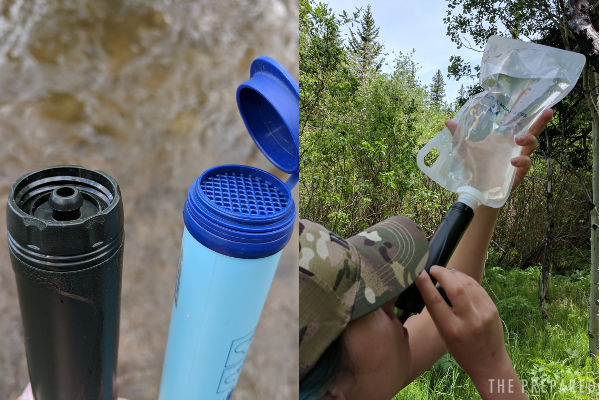
Survivor Filter is technically a white-labeled Chinese product (it’s the exact same model as the old Renovo Trio straw). But this brand has been around long enough to establish itself with a responsive US presence and lifetime warranty, and we’ve personally used this straw as a backup for years. We chose it over the better-known LifeStraw because it has a US-lab-tested 0.05 micron filter (LifeStraw’s is 0.2 micron) and a 28 mm thread on the input end so you can screw it directly onto most normal plastic bottles (the LifeStraw can’t). It has a carbon filter and replaceable parts. It’s very difficult to suck through without using the bottle attachments, but good enough when attached to a soft/squeezable canteens — the Survivor Filter Squeeze Kit is $10 more but comes with two 33 oz bags.
The competition
Aquamira Frontier Straw. $12. 110 L (30 gal). 1.0 oz weight. The Frontier straw has been around for a while, but it doesn’t even cover the basic bacteria and protozoa protection levels, instead only covering “protozoan cysts” (which are the largest types of threats). Pass.
Aquaway Pen. $15. 0.1 micron filter for 1,000 L (260 gal). 1 oz weight, 5.4” long. Carbon filter. Comes with pre-filter replacements. No website, likely Chinese or white-labeled. Pass.
Alexapure Survival Spring. $18. 0.2 microns filter for 1,135 L (300 gal). 1.6 oz, 8.8”. Includes a carbon filter. 28mm thread. Sometimes branded as a My Patriot Supply filter. Endorsed by survivalist Les Stroud. Carry lanyard. No backwashing, dispose of after 300 gallons.
Etekcity Straw. $15. 0.1 micron filter for 1,500 L (395 gal). 2.1 oz. 1 year life once used. Can be backflushed. 28mm thread. Carbon filter. This is the white-label version of the Chinese Diercon Straw. Dislike that the pre-filter attachment requires a separate piece of plastic tubing. Comes with a poorly-reviewed soft canteen and pre-filter replacements. Decent protective cap. Lab tested. Likely a white-labeled version from the Chinese manufacturer Diercon.
Glacial Stream Straw. $12. ? micron. 755 L (200 gal). 0.5 oz, 8”. Tiny, like a pencil. Carbon filter. Not cleanable. Unclear product info. Pass.
Life Defender Straw. $20. 0.01 micron. 1,500 L (395 gal). 2 oz. 28mm thread. Can attach tube to inlet. Carry lanyard. Carbon filter. 5 yr shelf life. The protective cap seems weak. Conflicting info from manufacturer regarding filter size and viral protection.
LifeStraw Personal Filter. $17. 0.2 micron filter for 4,000 L (1,040 gal). 1.6 oz, 7.9”. No 28mm threads. Carry lanyard. Relatively large filter pore size for this class, which lets more threats through but is easier to suck. No carbon filter. Independently tested. Popular brand/product with over 88,000 Amazon reviews, but we think it’s overhyped for preppers.
Sagan XStream Straw. $60. 2.0 micron filter for 945 L (250 gal). 6.2 oz, 7”. Virus protection (uses the special mesh tech with larger pores) and lab tested. This is a unique kit that we weren’t sure how to categorize, but Sagan calls it a straw, so here it is. It can be a straw in that you dip a long hose into your source and draw water through the other end with your mouth. But it also has a hand pump bulb (similar to the MSR AutoFlow), so you could squeeze instead of suck, which also makes it usable as a shower and equipment cleaner. Might be interesting for your kit, but we’d think more highly of it if the filter life was better.
Seychelle Radiological Straw. $30. Unknown filter for 95 L (25 gal). Only filters 25 gallons of water because it’s a very beefy filter that covers radiological threats. Only consider this if you’re specifically thinking about nuclear preps. NSF 42 and 53 certified.
Best filtered water bottles
- We recommend keeping drinkable water stored in your BOB/GHB anyway — using a filtered bottle can be a good way to hit two birds with one stone, even if you keep the filter part detached during storage so it’s not sitting in water.
- We tend to dislike soft/collapsible vessels with internal filters. They can be great for lightweight hiking, but are not durable enough for emergency preparedness. Many products have consistent complaints of leaks in the vessel. If you’re going to go that route, you may as well get normal unfiltered soft pouches with 28 mm threads (like a Platypus bag) to use with your other, more versatile water filters.
- Bottle filters generally have a shorter life than other product classes, but are typically replaceable for $10-30. Some are backwashable.
- Better filters can be harder to suck water through because of the smaller pore sizes. Some bottles are soft or semi-squeezable so you can help push water through, while a few newer models (like the Lifesaver bottles) use extra pump/press mechanisms to assist.
- Don’t get tricked into buying a “filtered” water bottle that is more about turning tap water into “better” water with pseudoscience marketing for “wellness”, “ionization”, pH levels, fluoride, etc.
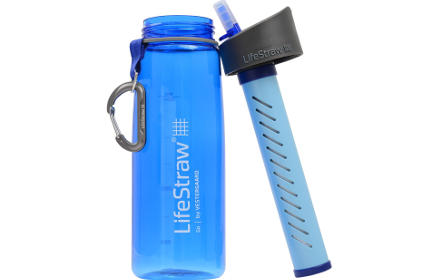
Best for most people:
LifeStraw Go Bottle
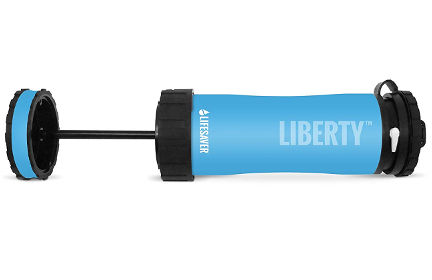
Virus protection with pump assist:
LifeSaver Liberty Bottle
Fortunately, the LifeSaver Liberty is still available directly from Lifesaver, offering virus protection without destroying your cheeks with hard-to-draw-from filters. The LifeSaver’s super-fine 0.015 micron filter would be too hard to suck through on your own, so there’s a pump built into the base that adds some weight (15 oz total) and reduces overall water capacity (only a 13.5 oz bottle) in order to pressurize the system. Main filter lasts 2,000 liters (528 gal) with a replaceable 100 liter carbon filter. Comes with input and output hoses, so you could also think of this as a pump with a built-in bottle.
We’ve also explored bottle solutions like the Grayl Geopress, and while it might seem appealing at first glance, we couldn’t find any documentation from independent testing for its certifications. Even more concerning, the NSF has issued a public notice stating that “Grayl is not authorized to use the NSF certification mark or make any claims of NSF certification.”
On top of that, many user reviews mention that the filter tends to clog very quickly. This makes filtration slower and more difficult over time. Ultimately, for truly reliable virus protection, we generally suggest opting for a non-filter bottle solution. If you decide on the Grayl Geopress, do yourself a favor and pickup at least backup filter or a prefilter to extend its longevity.
The competition
Berkey Sport. $45. 22 oz bottle. 378 L (100 gal) filter. 4 oz weight. Squeeze bottle. Berkey is a well-known water company, but this product is a miss and perhaps white-labeled from a cheaper manufacturer. No clear filter info with vague tech claims. We dislike the mouthpiece tube, as it seems flimsy and there are reports of mold growth and leaks. We also dislike the way the filter hangs inside the bottle.
Brita Bottle with Filter. $9. 20 oz bottle. 150 L (40 gal). Popular brand, but this is not a survival filter, similar to how their well-known kitchen filters just make tap water “better”. Pass.
Grayl Ultralight Filter Bottle. $70. 16 oz bottle. 150 L (40 gal) filter. 2.0 L/min. 10.9 oz. Virus and metal protection. Popular and well-reviewed, but we think it’s only desirable for stylish everyday carry. Carbon filter. Smaller bottle, partly due to a design that uses a unique “french press” motion instead of filtering as you suck water out. Innovative, but we have concerns about this design in an emergency context (including the very small lifespan) and reports of leaks and cross-contamination increase our suspicion.
HydroBlu Clear Flow. $22. 24 oz bottle. 0.1 micron filter for 1,500 L (395 gal). 7.8 oz weight. Carbon filter. There were significant reports of leaks and failures in 2017, but HydroBlu tells us in 2018 that they’ve fixed the issue. We’re not a fan of the physical bottle design, including how the filter attaches to the inside of the cap.
Katadyn BeFree Collapsible Bottle. $40. 20 oz soft bottle. 0.1 micron filter for 1,000 liters (260 gal). 2 oz weight. Katadyn is a solid company, but this tiny “crushable” bottle is built for ultralight hiking in normal life, not emergency preparedness, and we’ve seen reports of bag failure and durability issues. Although it could be a good option for compact EDC. Recently selected as an Editor’s Choice by Outdoor Magazine.
LifeSaver 4000UF Ultra Bottle. $158. 25 oz bottle. 0.015 micron filter for 4,000* L (1,056 gal). 22 oz weight. Most expensive and heaviest bottle on our list because it has a pump built into the base, which reduces the pressure you need to create from sucking. Good filter that includes virus protection. Carbon filter, but only lasts 500 L, replaceable for $10. Lab tested. Seems well built but there are reports of pump failures / leaks, and we dislike that you have to scoop the mouthpiece end into contaminated water.
Miniwell L620 Soft Bottle. $21. 23 oz bottle. 0.1 micron filter for 1,000 L (260 gal). 2.9 oz weight. Chinese, questionable service / support and inconsistent product info. We don’t like the soft bottle design in these products because it doesn’t protect the filter while in your bag. Carbon filter. Lab tested.
OKO H2O Level-2 650ml Bottle. $25. 22 oz bottle. 2.0 micron filter for 378 L (100 gal). 4.9 oz weight. Softer bottle, which we dislike. Filter is not backflushable and uses a NASA-derived tech with larger pore sizes and charged mesh materials. Higher than normal reports of leaks / quality issues.
Platypus Meta 1.0L. $37. 25* oz bottle. 0.2 micron filter for 1,000 L (260 gal). 6.9 oz weight. Unique bottle design withs pros and cons. We not fans of how the split design reduces the amount of water you can carry and/or makes it larger than it needs to be — reducing the stated 1.0 L capacity to about .75 L (25 oz). Pro: The top half is rigid, protecting the filter assembly, while the bottom half is squeezable, which helps with pushing water through the filter. Higher than normal negative reviews and reports of product quality problems. Easy to clean filter in the field.
Purewell Bottle. $25. 22 oz bottle. 0.01 micron filter for 1,500 L (395 gal). ? weight. Looks white-labeled, identical to the Life Defender bottle, with no US company web presence. Carbon filter. Comes with small compass integrated in cap and a cheap paracord bracelet and flint.
Renovo MUV Nomad. $27. 24 oz bottle. ? micron* filter 340 L (90 gal). 8.5 oz weight. Virus protection*. Lab tested. We like the mouthpiece flip cap design. Renovo uses modular filters, MUV 1-2-3. MUV1 is a carbon filter and MUV2 is a 0.1 micron filter (good, but no viral protection). MUV3 uses the same large-pore charged filter NASA tech as the OKO bottle, which probably works fine for normal use, but we’re uncomfortable with for long-term emergency uses. You could probably put the MUV2 filter in the Nomad bottle, but the bottle comes with the MUV3 filter — which does filter viruses but only has a 340 L life. It doesn’t look like you can stack more than one of the MUV modular filters together inside the bottle.
Sawyer Personal Filtration Bottle. $44. 34 oz bottle. 0.1 micron filter for 378,000 L (100,000 gal). 5.5 oz weight. The 0.1 micron filter is “absolute”, so it’s still a great filter that lasts a tremendously long time. Comes with backwash syringe. Filter assembly can be removed and used inline with bladders/gravity bags. Easier to drink through than other filtered bottles. But we think the bottle/cap design and durability should be better. 63 mm bottle cap assembly (including filter) can fit on Nalgene-style bottle. Sawyer is a top name in prepper water filters.
Seychelle Flip Top Bottle “Advanced”. $30. 28 oz bottle. Unusual filter for 378 L (100 gal). 4.8 oz weight. Multiple models. The Advanced model removes viruses and has some extra iodinated resin tech to remove metals, fluoride, and radiation (unusual for bottle filters). Seychelle is a reputable company, but this squeezable bottle has higher than normal reports of leaking. Doesn’t work well when less than half full.
SurviMate Water Filter Bottle. $27. Another white-labeled copy of the same Purewell, Life Defender, etc bottles above. We don’t believe the micron rating. Pass.
WaterBasics Filtered Bottle. $30. This is the same Aquamira bottle above, and made/sold by Aquamira, but sometimes listed as a separate brand.
Woder 24-Sur Bottle. $24. This is a white-label version of the Berkey bottle above. Pass.
Best pumps
- Pumps are great because you do the work with your arms instead of your mouth.
- They usually come with input and output hoses. Some include a sanitation bag to keep your output hose clean during storage.
- Pumps work better than most other types in shallow water sources like puddles.
- You can create as much clean water as you want… just keep pumping.
- Many pumps use ceramic for their filters, a naturally porous material that traps particulates. Unlike membrane-based filters that use backflushing to clean out the trapped particles, ceramic filters are scrubbed down by hand with a brush or cloth. It’s easy to do and has some advantages, such as visibly seeing how much life the ceramic has left (instead of guessing on other types) and you don’t need a backflush syringe.
- Ceramic filters can’t block viruses.
- Pumps only work when you’re pumping them. You can’t daisy chain them with a bladder, bottle, or gravity bag the way you can with inline models.
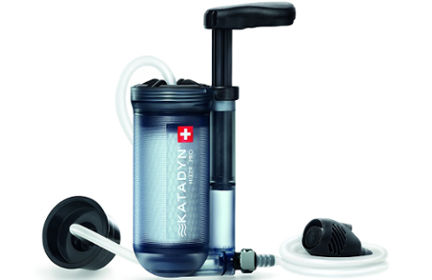
Best pump for most people:
Katadyn Hiker Pro Pump
Affordable virus pump:
Survivor Filter PRO Pump
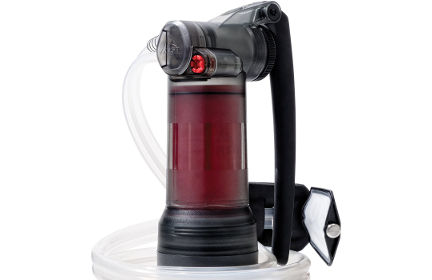
The best portable filter:
MSR Guardian Pump
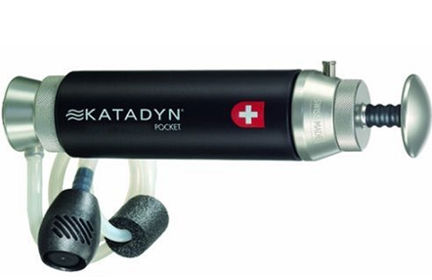
Extremely durable:
Katadyn Pocket Pump
A unique self-cleaning function means you never have to clean or scrub the filter the way you do with other pumps because 10% of the water is used to backflush itself on every stroke. Very high 2.5 L/min flow. Freeze-resistant. No carbon though, so it won’t do much for the taste or chemical protection. The bottom can screw onto a wide-mouth Nalgene bottle so the output water drops right in. We wish it came with an output hose, but you can add one if you’d like or use hoses/attachments from other systems/bladders. We also wish it had stronger materials like the Katadyn Pocket. Limited lifetime warranty.
The Katadyn Pocket is a very popular upgrade that can usually be found for cheaper than the Guardian. The 0.2 micron silver-impregnated ceramic filter lasts for a huge 50,000 L (13,000 gal). The Pocket is even larger than the Guardian at 20 oz and 10”. But some preppers feel it’s the best portable water filter on the market solely because it’s built for extreme use — this Swiss-made product is durable and well built, with solid metal parts instead of the plastic found on most others. Extremely long filter life, enough to keep one person alive for over 15 years. We wish it was easier to dry out for storage / during freezing temps, but it’s a minor complaint. Doesn’t come with a carbon filter, but they sell a carbon add-on piece. 20 year warranty.
The competition
Diercon Survival Filter. 0.01 micron hollow-fiber/carbon filter for 3,000 L (792 gal). 8.7 oz weight, 5.8” long. 600mL/min flow rate. Pump housing seems durable. Chinese, looks like they make many of the white-labeled products sold under middleman brands. Likely difficult to get support, but seems to pass muster with lab testing etc.
General Ecology First Need Elite XLE. $162. 0.4 micron filter for 680 L (180 gal). 16 oz weight, 6.25” long. Too large and cumbersome with not enough filter life for portable emergency use. Self-cleaning pre-filter and gravity assist system included. Can buy adapters for Nalgene/Platypus bottles or standard 28mm water/soda bottles. Unclear filtration info.
Katadyn Combi. $220. 0.2 micron ceramic/carbon filter for 50,000 L (13,000 gal). 21 oz weight, 11” long. At one point in the 2000’s the Combi was the best-selling preparedness filter — and it is a good, beefy filter — but not practical for personal prepping. It’s built for multiple uses, so you can take it out backpacking or attach it to your sink at home or in an RV. The extra cost and size/weight is not worth those features, so we prefer other models.
Katadyn Mini. $100. 0.2 micron ceramic/carbon filter for 7,000 L (1,850 gal). 7 oz weight, 7” long. Katadyn describes the Mini as less effective with backcountry water than the Hiker Pro, so while this is a good model, it loses to the Pro. Almost two-thirds lighter than the venerable Katadyn Pocket, but the portability and long filter life comes with the downside of taking longer than average to pump a liter of water. Silver-impregnated filter. Easy to clean in the field, with a smart built-in measurement tool that tells you when the filter is no longer good enough. The Mini has less pieces than the other Katadyn filters, which we always prefer. The input hose wraps up inside itself to store inside a compartment on the bottom of the filter, reducing the worries about cross contamination during storage.
Katadyn Hiker. $70. 0.2 micron glass-fiber/carbon filter for 750 L (200 gal). 11 oz weight, 6” long. A popular model for hikers, but for ~$20 more go with the Hiker Pro, which comes with better quick release hose attachment. Uses the same filter as the Hiker Pro and accessories as the other Katadyn products.
Katadyn Vario. $87. 0.2 micron glass-fiber/ceramic/carbon filter for 2,000 L (530 gal). 15 oz weight, 7” long. They named it a Vario because it has various filtration settings like “fast mode” and “dirty mode”. Fast mode is for cleaner water. This could make sense for hikers and campers, but in an emergency situation we think it’s counterproductive and prefer other models. Innovative dual-stroke lever pump, which pushes water through on the up and down strokes, resulting in a faster per minute flow rate. Has rechargeable carbon filter, but we dislike the way it’s done.
MSR MiniWorks EX. $125. 0.2 micron ceramic/carbon filter for 2,000 L (528 gal). 16 oz weight, 7.5” long. Limited metal and chemical protection via the carbon core. This model effectively replaces the old and popular MSR Sweetwater. Field maintainable without any tools, although there are higher-than-usual reviews about the filter clogging quickly, requiring frequent cleaning, and durability issues around the pump handle/piston. Similar to the Guardian, it’s designed to directly attach to certain bladders and Nalgene-style bottles, or you can attach a hose to the output nipple. Limited lifetime warranty.
Renovo MUV Backcountry. $68. 0.1 micron hollow-fiber/carbon filter for 378,000 L (100,000 gal). 13.5 oz weight. Similar to our criticism of other Renovo MUV products (which are designed to all be modular and swappable in the same product family), we think their hyper-modular design is innovative and potentially nice for normal hiking, but too overcomplicated for prepping. This pump only works when held vertically and has a 1-star rating on Amazon.
Seychelle Pump 2 Pure. $50. 0.2 micron filter info for 378 L (100 gal). 13.6 oz, unknown length. One of the few pumps that filters viruses, and the only that filters radiological contamination. But it only lasts for 100 gallons. Skip this model unless you very specifically care about radiological threats.
Best inline water filters
- If you’re only going to buy one filter, make it an inline model.
- The most versatile type — can be used on its own as a straw directly into a water source, screwed onto the mouth of a normal water bottle, attached to the hose of a hydration bladder, or even attached to the output hose of a larger vessel/bucket of water.
- The best models are surprisingly small and light, because they don’t have any pumps or other functions/attachments.
- Wide ranges of lifespan. Some models only last for 180 liters and some last up 378,000 liters. Don’t get caught up in the super-huge numbers though.
- All else being equal, a product that claims 300,000 liters isn’t inherently better than one claiming 200,000.
- No inline models filter viruses. Some unknown / Chinese manufacturers claim they do, but we’re skeptical.

Best single product for most people:
HydroBlu Versa Inline Filter Kit
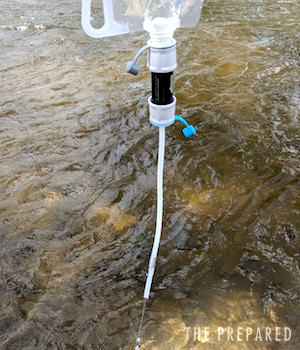
Our top inline pick is also our overall recommendation for most people. The HydroBlu Versa ($23 for filter alone, $26 for kit), named so for its versatility, has a lab-tested 0.1 micron filter lasts for 378,000 L (100,000 gal). The tiny 1.5 oz package is slightly larger than the popular direct competitor Sawyer Mini but smaller than the Sawyer Squeeze. Reviewers note the extra size allows for a flow rate that’s noticeably better than the Mini — a frustration that has lead many to abandon their Mini. Backflushable. We appreciate the 28 mm threads on both ends, something almost no other filter offers. The kit, which is only ~$3 more than the Versa filter by itself, includes two 64 oz collapsible bags, a tube, and a bucket adapter for gravity setups — making this a cheap gravity kit, too.
The competition
Aquamira Frontier Pro Ultralight. $30. 0.2 micron filter for 180 L (50 gal). 2.5 oz weight. One of the original versatile filters. Can run it as a straw, attached to a standard 28mm bottle, inline with a hydration bladder, or inline with a gravity bag. Uses Aquamira’s replaceable Series III Green line filters (bacteria/protozoa, no virus protection). Lab tested.
Aquamira Frontier Max. $50. 0.2 micron filter for 454 L (120 gals). 2.5 oz weight. Upgrade version over Aquamira’s Frontier Pro. No 28mm threading, is meant for hoses only. Universal quick disconnect hose nipples. The Pro uses Series III Green filters, while the Max uses Series IV filters in either Green (bacteria/protozoa) or Red (+ virus) versions. Lab tested. Some reviewers note the flow rate is lower than average for this class. Comes with a bite valve attachment to turn it into a straw.
LifeStraw Flex. $35. 0.2 micron filter for 2,000 L (528 gal). 1.7 oz weight, 4.7” long. Comes with a 22 oz collapsible water bottle, but reviewers don’t think the bag is durable enough to depend on (similar to the Katadyn BeFree). 28 mm threads on the input end. Besides normal bacteria/protozoa protection, it filters out some heavy metals like lead — the only LifeStraw model to do so. Replaceable carbon filter that lasts about 100 L. Backwashable.
OKO Survivor. $30. 0.01 micron filter for 100,000 L (26,400 gal). 3.9 oz heavy, 5.25” long. Virus protection with “absolute” 0.01 micron rating tested in US labs. Comes with some hose and a bite valve, plus a bulb-style hand pump you can run inline to squeeze water through with your hand, making it versatile as a shower or equipment cleaner. Seems like a decent kit and filter for the price, but we can’t find much about the product/testing and it’s not available on any common vendors.
Purewell Filter. $13. 0.01 micron filter for 5,000 L (1,320 gal). 2.0 oz weight, 5.4” long. Chinese company with unverifiable filter claims. 28 mm threads on the input end. Filter is not replaceable, but is backwashable. Pass.
Renovo MUV Survivalist. $65. 0.1 micron filter for 378,000 L (100,000 gal). 9.2 oz weight. Virus protection. Part of the Renovo MUV modular system. We don’t think the Renovo products are worth it unless you buy the entire kit so you can get the benefit of all the modular options. Otherwise, each specific type is inferior to competitors, a kind of jack-of-all-trades-master-of-none problem. It’s an interesting concept and we love innovative manufacturers, but in this case it feels too complicated and too easy to misplace the parts. 28 mm thread, mouthpiece adapters, etc.
Sawyer Mini. $20. 0.1 micron filter for 378,000 L (100,000 gal). 2.5 oz weight. The most popular portable water filter for preppers — but we think it’s no longer the clear winner, and if you’re going to buy a Sawyer, many reviewers advise going with the Squeeze + aftermarket attachment parts instead. An easy to use and tiny package with a very long life. We dislike the flow rate compared to its bigger brother the Squeeze (which is 2x faster) or competitors like the HydroBlu Versa, and many other reviewers highlight the same criticism. Because of its tight package, it needs to be backflushed more often than competitors. There are also reports of seals/attachment points breaking, but that could be noticeable simply due to how many people own one. Comes with a 16 oz collapsible bladder and a tube straw. 28 mm threading on input. Backwashable. Lab tested. If you have one or get it anyway, check out the Sawyer Bucket Kit.
Sawyer Squeeze. $30. 0.1 micron filter for 378,000 L (100,000 gal). 3 oz weight. In many ways the Squeeze is similar to it’s smaller brother, the Sawyer Mini, but with a faster flow rate (over 2x better than the Mini) and less frequent need for backflushing. The downside is it’s slightly larger and has fewer out-of-the-box configuration options. The core use-case is the same: Fill the included 32 oz collapsible bladder (or any 28 mm threaded bag) with dirty water, screw on the Squeeze, then squeeze water out into any clean water vessel. It does have aftermarket attachments to place it inline with hydration bladders or gravity bags, but it feels like an afterthought configuration. The complete kit is about $20 more than the base model. Lab tested.
Best gravity kits
- Produces more water per minute than most other types and requires the least amount of physical effort because gravity does the work instead of your mouth or hand.
- Gravity kits are usually just a hangable bag and hose with an inline filter attached to the output hose. Some have the filter built inside the bag itself.
- Gravity bags are very popular and often the highest-rated portable filtration products in outdoor-focused publications or stores like REI.
- But that popularity is usually in a family camping context, because they filter water for large groups of people without much effort or moving around.
- We think there is prepping value in having the option to use gravity. It can make daily chores in a fixed position (like your home) much easier. But it’s a nice-to-have on top of a good foundation, not a need-to-have.
- We don’t like most of the off-the-shelf kits for one big reason or another.
- A DIY approach is probably better, where you pair an inline filter with any bag and hose. But our top choice gets you 95% of the way there. Assuming you have an inline filter anyway (like the Sawyer Mini), the extra weight/space of adding a gravity water bag and hose in your emergency kits is worth the benefit.
- Gravity bags are hard to use when water isn’t plentiful or deep, and you need elevated places to set the bag. They work well in wooded areas with lakes and rivers. But you shouldn’t assume that’s where you’ll be in an emergency.
- The models that use an inline filter on the output hose are easy to backflush. You just flip the filter around and let gravity push out the particulates.
- We don’t think you need two bags in a gravity kit. You always need a dirty bag. But the value of a special clean bag isn’t really applicable to prepping, except for the value of having a second bag to replace a torn dirty bag. If you need to fill something up, like a bottle or cooking pot, just take it to the dirty bag and let gravity fill your vessel. A separate clean bag doesn’t really improve that process except for saving small amounts of time.

Best gravity kit:
HydroBlu Go Flow Gravity Kit
The closest competitor, the Sawyer Gravity System, is almost the exact same price but comes with the Mini filter (which we think is inferior to the Versa) and an inferior bag that’s 60% smaller. The MSR AutoFlow and Platypus GravityWorks are both popular and well-reviewed options, but we can’t justify the extra $80-120 price without clear benefits for preppers.
The competition
Katadyn BeFree Gravity 6L. $120. 6 L bag. 0.1 micron filter for 1,000 L (264 gal). 8.9 oz weight. Katadyn’s gravity filter has evolved, and this is their current offering, now running on the BeFree filter tech. It’s still a 6 L bag system, but the big change is the 0.1 micron BeFree EZ-Clean Membrane. The stated filter life is around 1,000 liters, which is actually less than the old model’s 1,500 L. But here’s the trade-off: this thing consistently flows fast and it’s genuinely easy to clean in the field – just shake or swish it. That’s a real improvement over the older filter, which had its share of early clogging complaints.
The BeFree filter itself is integrated into the bag assembly, and while some folks prefer totally separate inline filters for repurposing, the BeFree is so versatile on its own that it’s less of an issue here. At this price, it’s a solid option for group filtration. We still appreciate the sediment trap that tries to keep the worst grit out of the main filter, and the bag still has that helpful transparent stripe to see your water level. Quick-detach hoses are still present, and yes, it’ll connect to many hydration bladders. You can still rig it up as a shower with an aftermarket adapter. It’s field cleanable, and frankly, it’s a lot less fuss than the previous iteration.
LifeStraw Mission. $120. 5 L bag. 0.02 micron filter for 18,000 L (4,755 gal). 13 oz weight. Virus protection. 12 L bag option. Field-cleanable pre-filter in the bag. We think it’s a little over complicated to use, with a primer pump that isn’t intuitive for our “10 year old child” test. But it’s a solid filter with a long life.
LifeStraw Family. $70. 12 L bag. 0.02 micron filter for 18,000 L (4,755 gal). 15 oz weight. We’re not really sure why LifeStraw has the Mission and the Family product lines. They’re essentially the same thing, with the Family using a rigid “bag” instead of the collapsible roll-top bag on the Mission. The large rigid container effectively disqualifies this for portable emergency preparedness.
MSR AutoFlow. $130. 10 L bag. 0.2 micron filter for 1,500 L (395 gal). 12 oz weight. Basic bag with an inline filter in the output hose. Meets NSF protocol p231 for removal of bacteria (99.9999%) and protozoa (99.9%) from beginning to end of filter life in “worst-case water.” Output attaches to many common bottles and bladders with a universal adapter. Field cleanable and backflushable (which will be needed) with a sediment trap to maintain decent flow.
Platypus GravityWorks. $120. 4 L bag. 0.2 micron filter for 1,500 L (395 gal). 11.5 oz weight. One of the two most-often-recommended gravity kits, alongside the MSR AutoFlow, but it’s better for stationary camping than portable survival. Uses the exact same inline filter as the AutoFlow but comes with two bags (clean and dirty) instead of the MSR’s one. They also offer a single 2 L bag kit for $20 less. We dislike the zip-loc style bag closure, but think these bags are more durable than those in the MSR kit. Field cleanable, backflushable.
Renovo MUV Tote. $49. 0.1 micron filter for 378,000 L (100,000 gal). 10.6 oz weight. Not worth it as a bag kit. If you’re going to buy Renovo, you may as well get their complete modular kit, otherwise you’re taking on the downsides of their products without any of the benefits (modular versatility). Uses the same 10 L bag as the HydroBlu Go Flow with a hose and the standard Renovo MUV2 filter. Comes with mouthpiece to turn the filter into a straw.
Sawyer Gravity System. $40. 3.8 L bag. 0.1 micron filter for 378,000 L (100,000 gal). 8.8 oz weight. Simple combo kit of the popular Sawyer Mini inline filter with a 1 gallon bag and hose. Includes a push/pull on/off valve cap. The Mini is 28mm threaded on each end, so you can take it out of the gravity setup and use it like a normal Mini (e.g. screw it onto a normal water bottle). The bag is notably inferior to other kits, so you could always buy any hanging bag with hose output you’d like and just put a Mini filter inline.
Sawyer Point Zero Two. $110. No bag. 0.02 micron filter for 378,000 L (100,000 gal). 12.8 oz weight*. Virus protection. A unique kit from Sawyer that doesn’t come with a bag — it comes instead with equipment to make your own gravity setup using any bucket. The size and weight are just for the kit. In the end we don’t think this makes sense for portable setups, but could be a great home-based kit. Also comes with a faucet adapter, which makes backflushing this very fine filter easier and more thorough, extending its life.
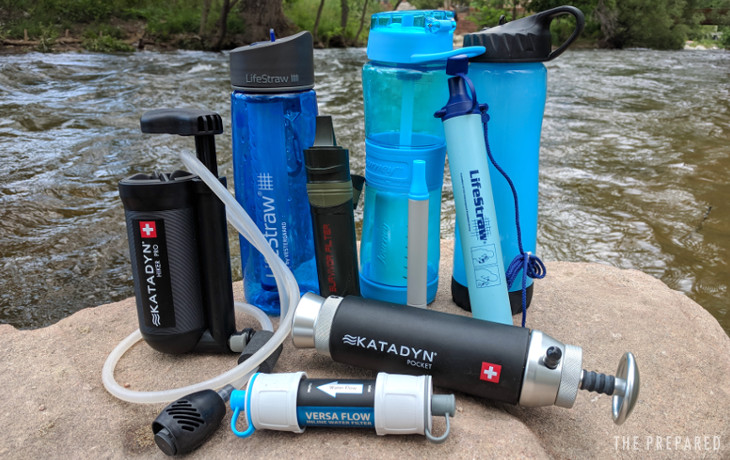
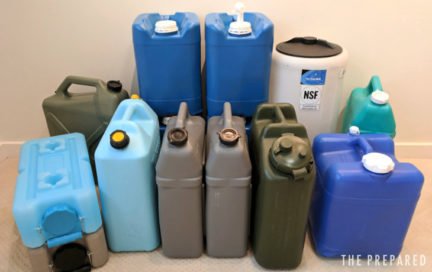
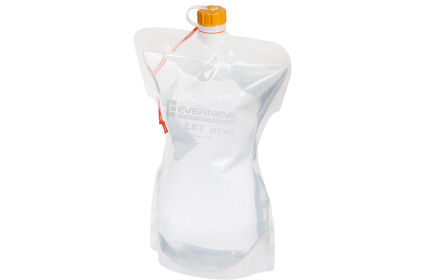
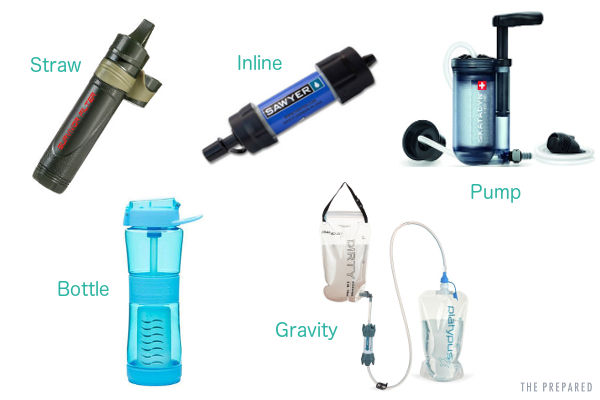
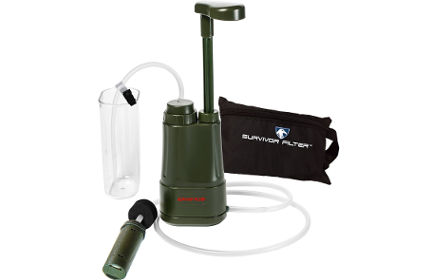
You are reporting the comment """ by on